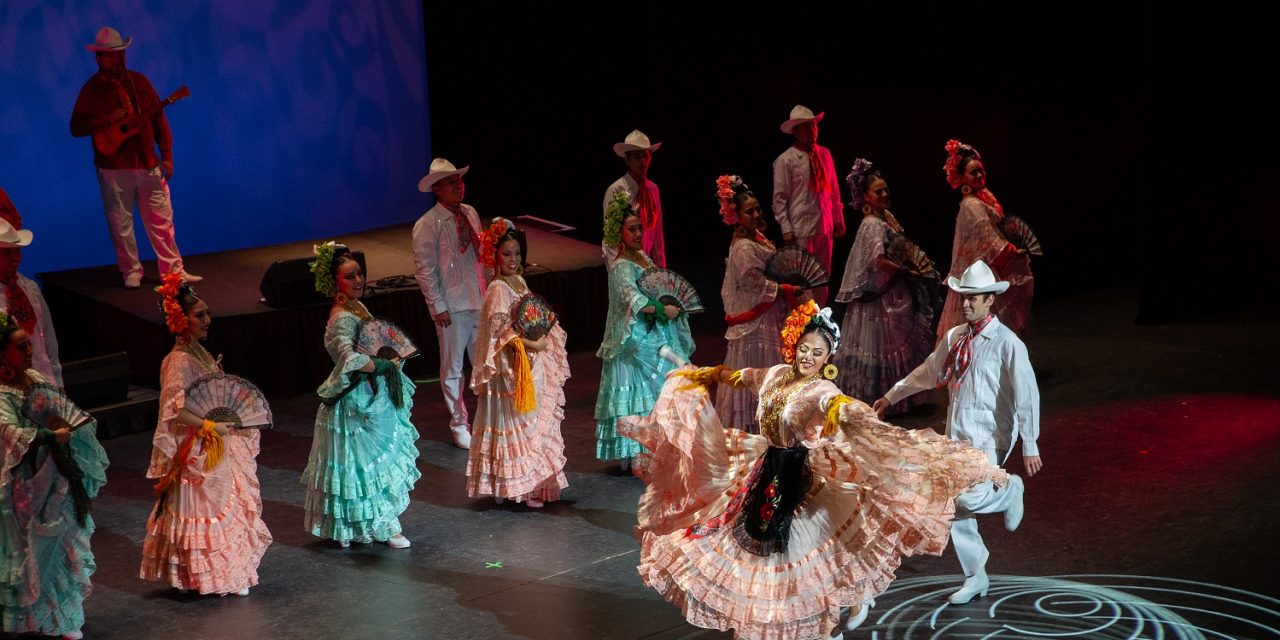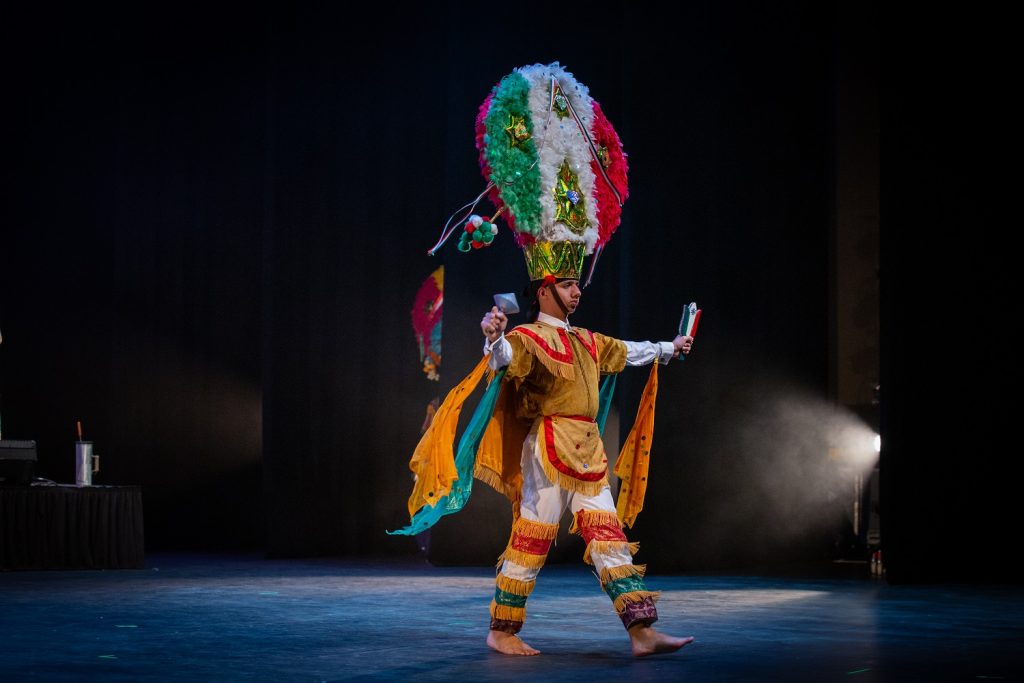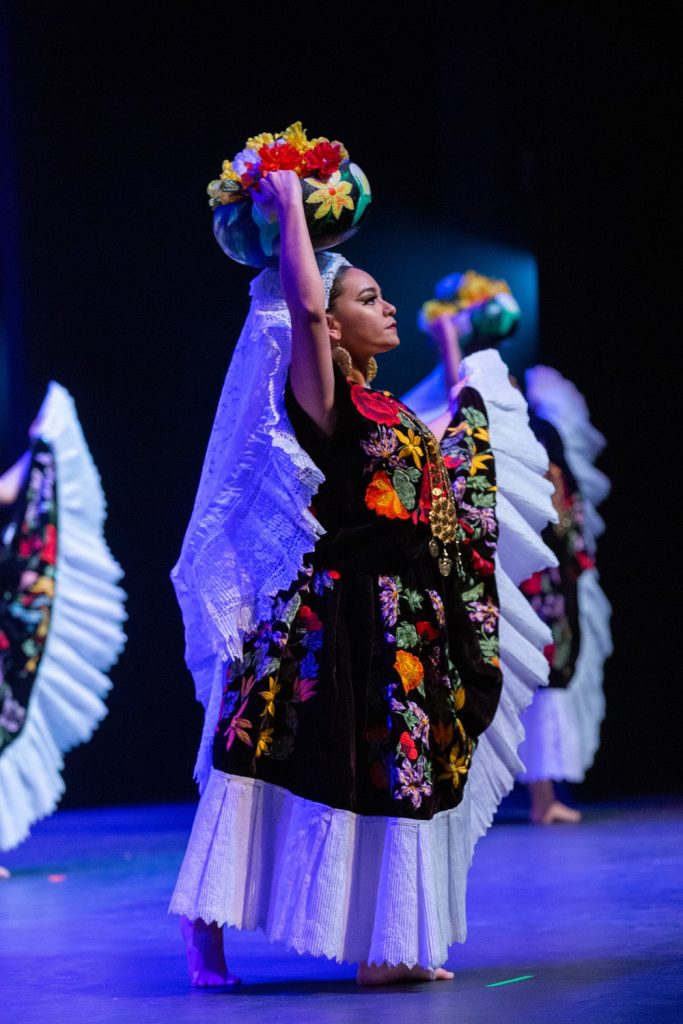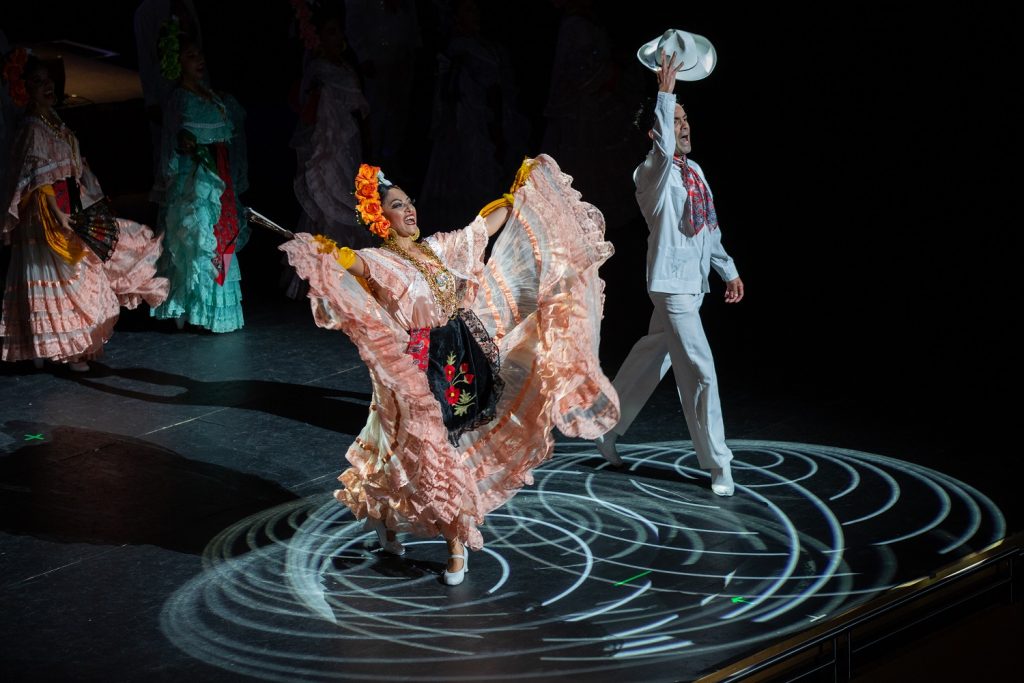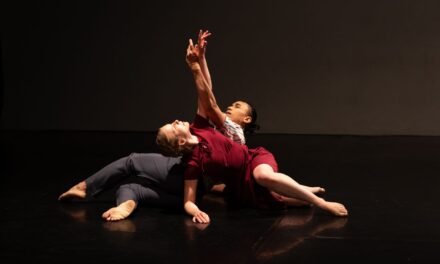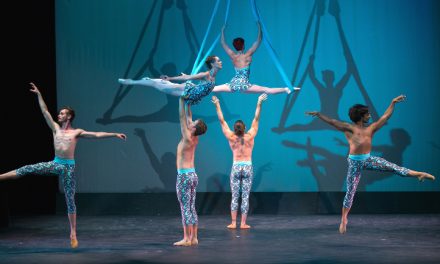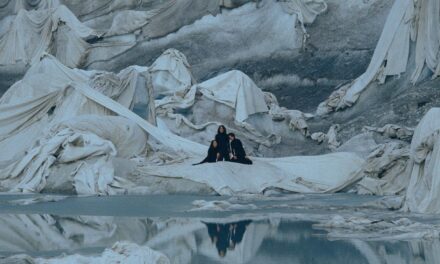Silvia Lozano’s Ballet Folclórico Nacional de México (BFNM)’s January 30 event at The Soraya was a beautiful exposé of Mexican tradition. Now in its 60th year, the company’s goal is to continue to preserve their country’s cultures and customs by showcasing performances from several regions. Performed by a fantastic troupe of talented dancers, the production was executed with precise synchronization, elegant grace, and an uplifting spirit that elicited a well-deserved enthusiastic response from the audience.
The program notes guided unfamiliar audience members through the performances with blurbs about the 11 states whose many dances (some regions were only represented with one, while others included up to five) were featured throughout the course of the evening. Details about how the locations’ folklore and rituals influenced the movements and melodies helped bring the choreography to life.
Music was a key component to the work. Two different musical groups performed during the two acts. The first was Los Antiguos, a trio directed by Sigfrido Gámez Ibarra. The second was Fredy Sánchez Jiménez’s Mariachi Tradicional de América, a large band consisting of eight musicians playing a variety of stringed instruments. It took an army to produce the rich sounds that reverberated throughout the hall. Pre-recorded music featuring the marimba (a string instrument with African origins) occasionally blasted through the speakers, but the majority of the time, the music was live. The result was a gorgeous soundtrack that added an earthy element to the footwork, complementing, but never competing, with the ensemble’s dancing.
In between dance segments, the bands were given moments to shine on their own while introducing upcoming dances from their assigned regions. Standouts included the unnamed musical number in Veracruz Antiguo, which introduced the African-and-Caribbean-influenced work: Los Negros/El Toro Zacamandú (“The Bull Dance”). The playing fully activating the sharp zapateados or foot stomps native to the choreography. In Michoacán, high-pitched violin-playing was used to announce Los Viejitos (“The Old Men”), a quintet of dancers who wore sunburnt masks and paid tribute to Tata Jurhiata (“sun god” or “old god”) by raising their sticks in the air, all while falling over each other in a comic tribute to the elderly village men that came before them.
Humor played a major role throughout the show. Chiapas, where the Zapotec people live, included El Jabali (“The Wild Boar”), which had the beast in question running around and terrorizing the female dancers dressed in eye-catching red and gold costumes. They squealed every time one of the male dancers bearing the boar’s head pulled on their skirts and pretended to grab them. The bawdy movements never wandered into the category of offensive. Instead, they led to an empowering moment whereby the women attacked and helped defeat the animal, delivering a final, fatal blow after a group of protective men had “punctured” it with their swords.
The majority of the dances involved props (designed by Gerardo Juárez García), particularly Oaxaca’s choreography, which most prominently included ornate headpieces that influenced the gate of the dance. The men performing La Danza de la Pluma (“The Feather Dance”) made long, sweeping motions across the stage reminiscent of gliding eagles while balancing large, colorful headpieces as they paid tribute to an Aztec legend: the dream Moctezuma had in which he envisioned himself as a bird warning his people of the coming Spanish invasion. Meanwhile, La Sandunga (“The Elegant Waltz”) saw the matriarchal Tehuana women, known as shunkas, carry round clay pots full of flowers over their shoulders. Their heads were held high as their feet moved in small, pitter-pattering circles across the stage.
Handkerchiefs and streamers were another common accessory incorporated into many of the dances. When portraying the Yucatán, the Yucatán Popurri based its choreography in El Baile de las Cintas, or the ribbon dance, which incorporated a maypole-like structure that reflected the gaiety of the often-celebrated vaquerias or ranch festivities the region is known for. The performers’ weaving and partner-switching movements on the ground created impressive, perfectly braided patterns along the upper part of the pole.
Alongside these large group numbers were one-on-one partner dances. Guerrero’s Ella (“Her”) was a Chilean dance with Spanish origins — as made clear by the costumes reminiscent of señoritas and old bull fighters (also designed by Gerardo Juárez García) — that had made its way into the Mexican narrative. The objective here was for the traditional man-woman couple to attempt to steal each other’s handkerchiefs. Their come-hither interactions gave way to plenty of flirtation, particularly by way of a simultaneously sweet gesture seen throughout many of the couple’s duets throughout the night: a mimed head-tilting kiss.
When demonstrating something exciting, the performers would chime in with sharp whistles, and encouraging yelps and tongue trills that triggered an encouraging call-and-response reaction from the audience. The two states which most strongly included these moments were Veracruz Sotavento and Jalisco, both of which wrapped up their respecting acts. The former featured recognizable songs and numbers such as La Bamba, while the latter’s Tierra del Sol (“Land of the Sun”) finale rocked the entire building, particularly when the Mexican flag was waved on stage.
During this trying time in American history, it is more important than ever before to expose ourselves to a wide variety of foreign cultures and customs in order to supersede racism and better understand the world we live in. BFNM provides viewers with that opportunity with its unforgettable tour de México. The attention to detail paid in the costumes, musical origins, and choreographic conservation comes together to create a historically significant show, as well as an accessible one.
Dancers: Alejandra Cortez Vilchis, Andrea Thamar Rubí Santillán, Ángela Paola García Aguilar, Claudia Patricia Robles Cruz, Desireé Dander López, Diana Fabiola Camarillo Hernández, Jazmín Hernández, Lara Constanza García Meníndez, Mercedes Yazmin Hernández Cabrera, Miriam Alicia Garma Mendoza, Rebeca Denisse Crispín Álvarez, Selene Flores Rodríguez, Armando Guillen Serrano, Carlos Andrés Santana Granados, Cristian Uriel Olivares Martínez, Israel Amor Rivas Salas, José Alexis Guzmán Lorenzo, José Manuel Gámez Martínez, Miguel Alejandro Olivares Martínez.
Los Antiguos: María del Carmen Carbajal López, singer and jarana player (a guitar-shaped fretted stringed instrument from the south of Veracruz); Joel Olmedo Garrido on jarrana and guitarra leona (similar to a jarana, but with four strings instead of eight) and Ibarra himself on requinto jarocho (a plucked four- or five-stringed instrument).
Mariachi Tradicional de América: Cesar Arturo Ramírez Moctezuma and Tomas García Perdomo on trumpet, Jaime Peña Bustamante and José Manuel Aguillón Yañez on violin, Heriberto Becerro Hernández on viheula (a 15th-century fretted plucked Spanish string instrument, shaped like a guitar but tuned like a lute), Juan Gabriel Rosete Zempoalteca on guitarrón (a large, deep-bodied six-string acoustic bass), Luis Miguel Galindo Cortéz on guitar, and Sergio Delfino Chávez Ríos on harp.
Written by Lara J. Altunian for LA Dance Chronicle, February 4, 2020.
To visit The Soraya website, click here.
Featured image: Ballet Folclórico Nacional de México de Silvia Lozano – Photo: Luis Luque | Luque Photography

